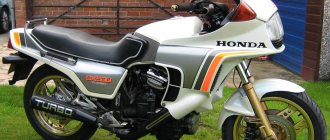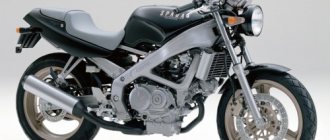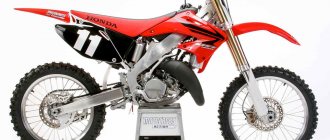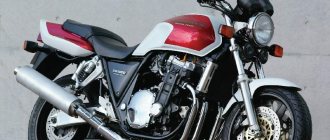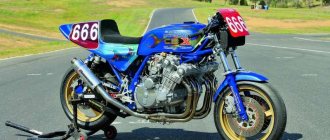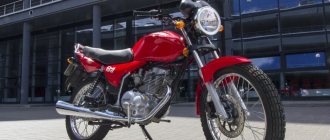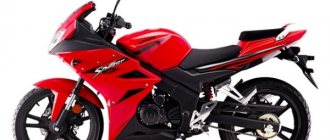The sports tourer Suzuki Katana 750 (official name Suzuki GSX 750 F Katana) appeared in 1989 and was positioned as the senior model of the line. Development was carried out in parallel with the younger version (GSX 600 Katana), so it is not surprising that some of the components of the motorcycles are common.
Even the restyling of models - the appearance of the second generation dates back to one year. But there are also differences - an aluminum frame, new carburetors, a full range of rear suspension settings, and a full-fledged engine.
Release Features
The first generation is a rectangular headlight.
Second generation – double headlight.
The model is being developed until 2007 . It was not intended for Japanese sales, but was exported to all countries/continents. Not often found on Russian markets. At the same time, most offers on the secondary market offer purchases with mileage in the Russian Federation. The price starts from 70,000 rubles .
Specifications
Engine – right side view.
Engine – left view.
Developed in parallel, both models received the same engine from the sports GSX-R750 , but on the older model they did not artificially limit it.
Although after restyling he still lost several horses. This is a regular 4-cylinder, 4-stroke, air-cooled four with in-line pistons.
Transmission and clutch
The chassis is identical to the younger version, the engine is equipped with a 6-speed gearbox .
The user had no questions about it - good, convenient numbers, pedal travel is within normal limits, it turns on clearly, neutral is located right away.
The main drive is standard - chain .
Brakes
There are few complaints about the brakes. The general opinion is that they are informative and even respond to stroking the controls.
Front brakes.
Rear brakes.
“ You stop where you planned .” True, in most cases they add - when driving alone. The presence of a second number does not reflect well on them.
In technical details they are identical to the junior katana. There are 2 discs on the front wheel , 1 . Diameter 290/240 mm , support for 2 pistons on both axles. During the restyling process, the rear disc becomes 10 mm narrower.
Installation of additional systems is not provided .
Short story
The history of this motorcycle dates back to 1979. Against the backdrop of the fact that the Japanese and Americans were fighting for the European market, and the competition was undoubtedly gigantic, specialists from Suzuki decided to take a risky step. They gave the order to Target Design (Germany). Suzuki said: do something unusual! The vague assignment gave room for imagination. As a result, they provided two prototypes: 650 cc. and 1100 cc.
The Suzuki guys really liked the prototypes and put them into production. The name was given to “Katana” - a samurai sword.
All Katana motorcycles were produced with an inline 4-cylinder engine.
Driving performance
The motorcycle's fairly long wheelbase is perfect for cruising on the highway.
The maximum speed stated in the documents is 223 km/h . The owners say that it picks up easily, with smooth acceleration without surprises, such as pick-ups. It is possible to do more, but for this you will have to bore up to 950 cubic meters.
Acceleration to hundreds (dynamics)
- Acceleration from zero to 100 km/h in 4.1 seconds . Interestingly, the young one in the strangled version shows the same indicators.
- Comfortable cruiser - 150 km/h .
Fuel consumption
Consumption, according to the manufacturer’s documentation, is 6.7 liters per 100 km . According to owners' reviews - up to 6 liters on the highway, up to 7.5 in the city. If you want to unscrew it “with all the money”, you can see 10 liters . Provided that the tank is 20 liters , the average distance on one gas station is 300-350 km .
Review of the Suzuki GSX 750 F Katana motorcycle
The katana came to me from Germany in May last year. There was a choice between the Honda cbr 1000 and the Suzuki gsx 750 f Katana, I fell in love with the katana at first sight) and what a sound it was, a song. Friends were all jealous, he was handsome (what one stop lamp is worth); moderately powerful (750 is still the golden mean); obedient. This is the first morning trip around the city, the fairer sex simply melted when they saw a katana, they smiled, waved their hands) and when you get closer, you give the gas, they squeal and jump. I rolled it until I vomited, when they asked what year it was, no one believed it. Of course, the men ran up with the words: “Bro, let me take you for a ride,” “Bro, I’ll give you the keys to the car, let me take you for a ride,” “Take me for a ride, I want to sober up,” “take me home,” “take me to the bar.” Of course, conflicts arose; I don’t hesitate to say that I shed blood for the katana). When it was raining for the second day, I couldn’t stand it and went to the garage to at least start it and rev it up in the garage) in the end it rolled out, it was just as much fun to ride as on a bright, warm day, except that then I had to wash it thoroughly. This bike is an ocean of fun. I got carried away. I got into an accident due to the fault of the woman driving the car, the fork was bent a little, the headlight needed to be replaced, and the plastic was damaged. However, I still rode it before the snow, without a headlight or plastic. BUT! Very, very neat. The brakes are informative, the engine came to me with a mileage of 71,000, no problems, acceleration is moderately calm, handling is excellent, I set it up as a sport bike, very comfortable (height 187, weight 91), went long distance, no health complaints. I can recommend it even to beginners, but with caution.
Not a bad budget sport tourer. competitor of vyfer, zizer 600 rf 600-900 and others like it.
The chassis does not shine with rigidity.
maybe the picker will do better. the engine is slightly redesigned and strangled from the Jixer 750 of 1990 (the same only even more strangled on the Bandit 750)
in terms of reliability, the engine is reliable….
It is possible to squish up to 955 cc, which generally won’t kill you if you don’t drive without oil. Well, everything else, without obvious jambs. in a nutshell, a budget sports tourer, without ambitions.
Quite easy to maintain. It doesn’t consume consumables like a liter (150-160th tank in the back, cheaper than 180th on the outboard, etc...) Something like this. I bought a friend such a katana, so I took it apart down to the screw...
I bought this at the beginning of the season, before that I had a previous katana, but the current one was 600k. I traveled a lot this season, but I went to St. Petersburg and back, and I also drove to Suzdal. In general, the bike is very versatile, the best fit for my height of 187 cm. Its ride is not ideal, even with the adjustments fully tightened - it is soft and loose, but not to a critical level. But all this gives good stability and comfort to the fifth point on a straight line, on broken asphalt and at joints. On Russian roads, that's what you need!!! Just don’t think that he is capable of anything; naturally, large pits are contraindicated for him.
There are no complaints about the engine, it pulls great, runs like a clock, only after winter it was reluctant to start for some reason.
Let's see what happens next. year Consumption is 6-7 liters outside the city, if you fry 10-11 The only strong minus for me is the brakes! Their potential is extremely small, they are enough for normal driving, but if with a passenger or if you brake frequently and sharply from high speeds, they float((((their effectiveness decreases sharply. The Honda will have better brakes. On foreign sites I found information that I am not the only one I'm complaining about the weak braking system, people are modernizing brakes and suspensions very well.
I also remembered a small minus, this motorcycle is not widespread in our country, which means there are very few spare parts at disassembly sites and in stores! For certain items, you won't find it during the day.
Modifications
There are no official modifications for katanas, but sometimes there are models with a volume of 8,00 or more cubes . There is no point in describing these developments of “folk craftsmen”.
and competitors
The bike couldn't do without competitors either. This is the older “sizer” - Kawasaki ZZR600, the older “vifer” - Honda VFR 750, and Yamaha YZF600R Thundercat. It is interesting that the latter, having a smaller engine capacity, produced identical power and torque figures.
MY MOTORCYCLE
The Honda VFR 750 F sports touring motorcycle model appeared in 1986 and existed until 1997.
A special feature of the motorcycle was a 4-cylinder V-shaped liquid-cooled engine, producing from 98 to 104 hp. (depending on the year of manufacture) power and 76.5 Nm of torque. The motor was built on the basis of the VF700 engine, which had a rather low reputation due to its unreliability. Honda engineers did a great job of lightening and improving this engine, resulting in a motor that was not only more productive, but also had a huge service life. Gears were used instead of a timing chain.
The Honda VFR 750 model received many awards in its time and was recognized as the best sports motorcycle in the 750 cc class for 6 years in a row. The reliability, durability and technical characteristics of the motorcycle were so outstanding at the time that the Honda VFR 750 model was often used as a police motorcycle - there was even a special version developed for this purpose - the Honda VFR750P. The Honda VFR 750 motorcycle existed until 1997, after which it was successfully replaced by an updated injection model - the Honda VFR800F.
Brief history of the model Over the entire production period, the Honda VFR 750 model went through several stages of development:
1986-1987 — 1st generation of motorcycle (model index — Honda VFR750FG/H; frame — RC24). Models of these years are distinguished by 16- and 18-inch wheels, plastic design, and produce 104 hp. power.
1988-1989 — 2nd generation of motorcycle (model index — Honda VFR750FJ/K; frame — RC24). Models of these years have a slightly different type of plastic, 17-inch wheels and a dry weight of 203 kg (instead of 199 kg).
1990-1993 — 3rd generation of the motorcycle (model index — Honda VFR750FL/M/N/P; frame — RC36). Models of this generation received new plastic, frame, cantilever swingarm and wider tires. The engine power is 98 hp, and the fuel tank has become 19 liters (instead of 20 liters).
1994-1997 — 4th generation of the motorcycle (model index — Honda VFR750FR/S/T/V; frame — RC36). These years' models feature slightly redesigned designs and other minor changes. This modification was the last, after which in 1998 it was replaced by an updated motorcycle model - the Honda VFR800F.
Fuel consumption Officially declared fuel consumption for the Honda VFR 750 F averages 6.7 liters per 100 km. The exact value depends on the riding style and technical condition of the motorcycle.
Technical characteristics of the Honda VFR750F (technical characteristics of different generations may differ): Model - Honda VFR750F Motorcycle type - sport-tourer Year of manufacture - 1986-1997 Frame - aluminum diagonal Engine type - 4-cylinder, 4-stroke, V-shaped Displacement - 748 cc cm Bore/stroke - 70 mm x 48.6 mm Compression ratio - 11.0:1 Cooling - liquid Number of valves per cylinder - DOHC, 4 valves per cylinder Fuel supply system - carburetors, 4 x 36 mm Keihin CV Type ignition - transistor Maximum power - 98-104 hp at 9500 rpm Maximum torque - 76.5 Nm at 8500 rpm Transmission - 6-speed Drive type - chain Front tire size - 120/70 VR17 Rear tire size 170/60 VR17 Front brakes - 2 296 mm discs , 2-piston calipers Rear brakes - 1 disc 256 mm, 1-piston caliper Front suspension - 41 mm Showa telescopic fork (without adjustments), travel - 140 mm Rear suspension - monoshock absorber with Pro-Link progression (preload adjustment), travel - 130 mm Length — 2180 mm Width — 700 mm Height — 1185 mm Wheelbase — 1470 mm Seat height — 805 mm Acceleration to 100 km/h — 4.0 sec Maximum speed — 243 km/h Fuel tank capacity — 19 l Weight of the motorcycle — 216 kg — dry 236 kg — loaded
Advantages and disadvantages
Although the motorcycle was developed one step later than the younger model, it nevertheless received several differences.
- The engine , although redesigned, is a full-fledged unit from a sports car.
- Suspension — a full set of settings in the rear, although according to user reviews, for convenience, you need to turn the adjustments to the tightest position.
According to users, the suspension is quite adequate - not too soft and not too hard, just right for our roads.
- New carburetors meeting Euro-1 standards.
- have difficulty starting when cold , but the older katana has real problems with this.
- Good handling created by a low center of gravity.
- Since a limited number of models came to Russia, it is not easy to find spare parts for it. You need to contact the factory immediately.
As the owners say, everyone wants to ride it, not just representatives of the fair half of humanity.
Overall, the Katana is a good sport-touring motorcycle, best suited for trail riding and short adventures.


